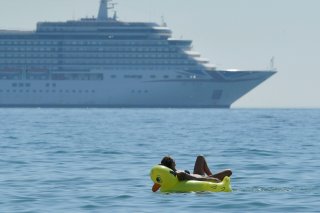The Cruise Industry is Sinking Thanks to Coronavirus
Between February and April, more than 19,000 British travellers from 59 vessels in 20 different countries had to be repatriated by the government.
On Sunday the first major cruise ship to take to the Mediterranean in almost five months sailed out of the Italian city of Genoa. Passengers on the MSC Grandiosa were tested for coronavirus before stepping on board. The ship – which has brought in an array of strict measures to limit the spread of the virus – will stop at three Italian ports and the Maltese capital Valletta in a seven-day voyage. But will these measures be enough to help the sector survive the pandemic? A lot is riding on the success of this Italian cruise.
After all, it was hard to imagine a cruise like this happening at all at the height of the pandemic – when ships were referred to as “floating Petri dishes”. Worldwide media coverage showed ships being turned away from ports and left marooned in the ocean with passengers stranded at sea.
It did look bad. Between February and April, more than 19,000 British travellers from 59 vessels in 20 different countries had to be repatriated by the government.
It wasn’t just bad news for tourists. In April, Andy Harmer, director of Cruise Lines International Association UK and Ireland (CLIA), said the 90-day cruise suspension would cost the UK economy £888 million, lead to the loss of 5,525 jobs and £287 million in wages. Across the UK, the industry supports 40,517 direct jobs paying £1.35bn in wages. CLIA says the industry generates £10bn annually for the UK economy.
COVID Cruises
So now the cruise industry is hoping strict new protocols will help it regain consumer confidence. New measures include: arriving at cruise terminals at set time slots; screening travellers with temperature checks, medical reviews, health questionnaires and an antigen COVID-19 swab test.
Guests on MSC cruises will receive a wristband, which provides them with contactless options on board. For example, wristbands can be used to open cabin doors without touching handles and for making payments. They will also help to facilitate proximity and contact tracing, if needed. The MSC Grandiosa has also reduced capacity, with about about 2,500 passengers on board its debut cruise – about 70% of normal, pre-pandemic, passenger numbers.
Other cruise companies are experimenting too. TUI Cruises and Hapag Lloyd recently concluded inaugural “no-call” voyages (so no city stop-overs) from Hamburg without incident.
Those two cruise companies have also produced ten-point plans to reassure passengers and encourage more people into travelling again. Points include: pre-boarding thermal image screening for travellers; social distancing; 40% less guests; table numbers in the restaurants reduced; fewer participants in sports and entertainment events; ships equipped with a laboratory and expanded medical teams. Crew members will undergo regular COVID tests.
All these measures will be needed to fight the virus and shore up customer confidence, as there has already been a failure. Earlier in August the expedition cruise ship, MS Roald Amundsen, owned by Norwegian firm Hurtigruten, suffered an outbreak of coronavirus during its week-long voyage to Svalbard in the Arctic.
Adapt or Sink
It is anticipated that prices will be reduced to entice passengers back on board. There are already deals available to book for next year, including discounts on cabin upgrades and drinks packages. But some firms are going further by considering domestic-only cruises to overcome travel restrictions. For example, cruise company Viking is investigating UK trips for Britons who are missing their cruise holidays. All these adaptions just go to show how innovative the industry is being to help encourage passengers to cruise again.
But will it be enough? To add to the sector’s pain, the Foreign and Commonwealth Office advice for the over-70s not to take cruises at all remains in place. Passengers aged 50 and above have represented the core customer base in recent years. And much of this came from the over-70s.
So it will be interesting to watch who returns first. Industry experts believe it will be passengers who travelled in inter-generational parties and fell in love with the cruise lifestyle who will return first – but with their children rather than their grandparents. They understand how cruise ships operate and are not in the high-risk age group. Research shows that “crisis-resistant” tourists are also less likely to be put off by the risks.
Although the long-term sustainability of the sector is uncertain, it can take solace in the fact that cruise passengers are notoriously loyal. Tourism studies have shown that visitors return even after a disaster. And, according to a survey conducted by CLIA, nine out of ten passengers said they “probably or definitely will” cruise again. Nevertheless, all eyes are now MSC Grandiosa to see if it can successfully navigate these tricky waters and give this ailing industry some hope.
![]()
Liz Sharples, Senior Teaching Fellow (Tourism), University of Portsmouth and Kokho Jason Sit, Senior Lecturer in Marketing, University of Portsmouth
This article is republished from The Conversation under a Creative Commons license. Read the original article.
Image: Reuters

